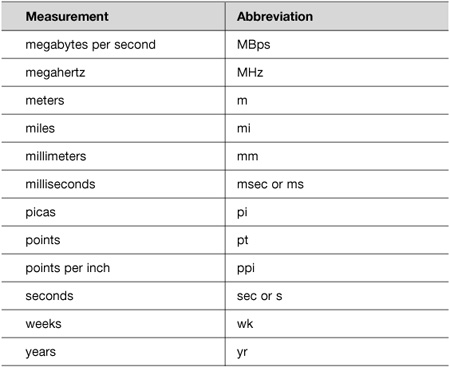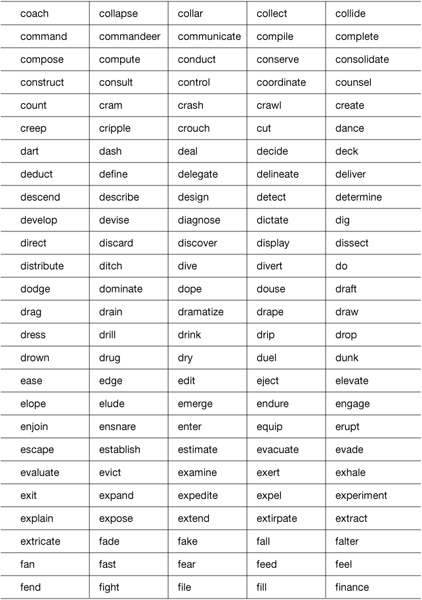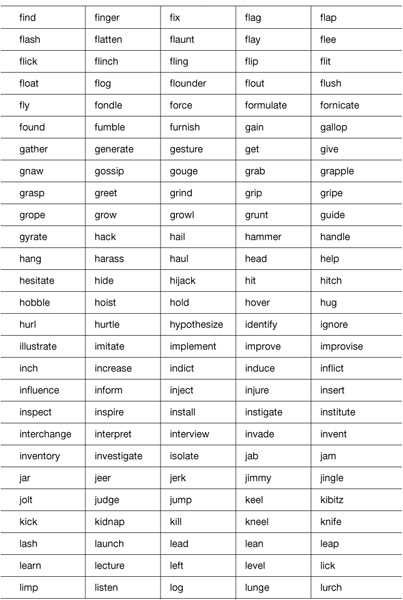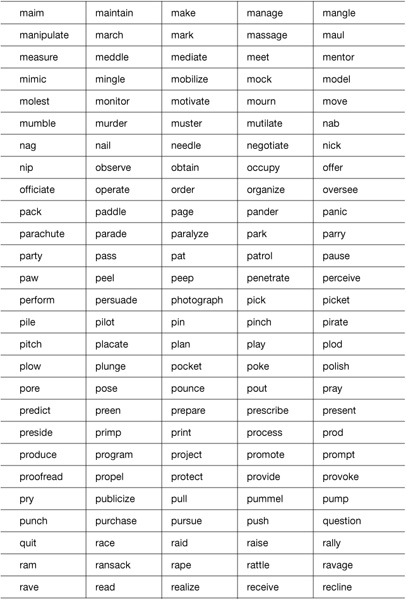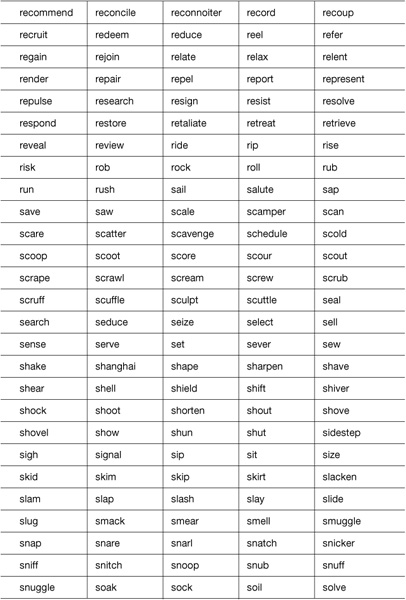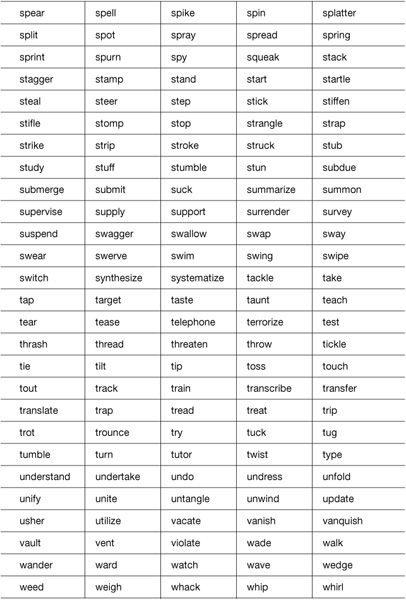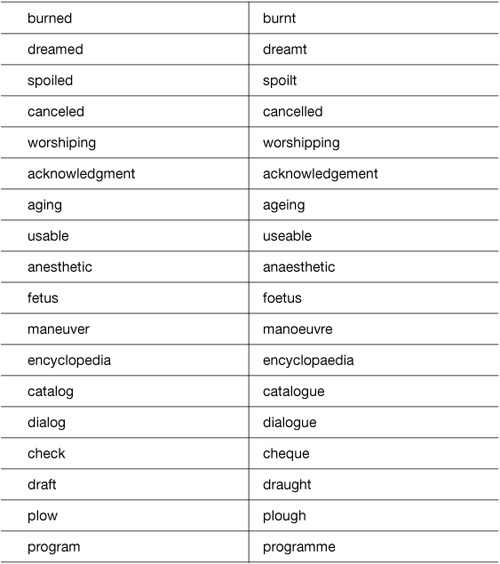A
A, AN
A and an are articles that proceed and identify nouns. A and an can also be used to mean one of something. The choice of a or an before a noun is based on the phonetic sound of the first letter in the word, not the written letter.
![]() A is used before all words that begin with consonants.
A is used before all words that begin with consonants.
Example: a kite, a man, a tomato, a large apple
Exception: An is used before words that begin with an unsounded h.
Example: an honor, an honest mistake
![]() An is used before all words that begin with vowels.
An is used before all words that begin with vowels.
Example: an apple, an egg, an Italian, an onion, an umbrella
Exception: When a word begins with u and sounds like you, then a is used as the article.
Example: a union, a used car
![]() When a word begins with o and sounds like won, then a is used.
When a word begins with o and sounds like won, then a is used.
Example: A one-time offer
Abbreviations
Abbreviations are formed from the first letters of words or shortened versions of a word.
Example: Automated Teller Machine, ATM
Example: Professor, Prof.
Abbreviations are used as space savers. Abbreviations that can be pronounced are called acronyms.
Example: AIDS is an acronym; HIV is an abbreviation.
Do not use periods with acronyms.
Example: NATO, North Atlantic Treaty Organization
Titles Before and After Names
![]() Use abbreviations for titles before names, and add a period after the abbreviation.
Use abbreviations for titles before names, and add a period after the abbreviation.
Example: Dr., Mr., Mrs., Rep.
Exception: Miss is not an abbreviation.
![]() Use abbreviations for titles or degrees after names.
Use abbreviations for titles or degrees after names.
Example: Sr., Jr., M.D., Ph.D.
Exception: Some sources do not recommend using periods for degrees.
![]() Don’t use periods for abbreviations used both before and after a name at the same time.
Don’t use periods for abbreviations used both before and after a name at the same time.
Example: Dr. Gary Wilson Jr
![]() Don’t use a comma to separate Jr. or Sr. at the end of someone’s name.
Don’t use a comma to separate Jr. or Sr. at the end of someone’s name.
![]() Don’t abbreviate a title that is not attached to a name.
Don’t abbreviate a title that is not attached to a name.
Correct: I went to the doctor yesterday.
Incorrect: I went to the dr. yesterday.
Names
![]() Familiar institutions are often abbreviated.
Familiar institutions are often abbreviated.
Example: MIT, FBI, UN
![]() Countries are often abbreviated.
Countries are often abbreviated.
Example: U.S.A.
U.S.A. can also be written as USA, but U.S. with periods is better. You can use U.S. as a modifier (U.S. foreign policy), but write it out (United States) when used as a noun.
Example: We want to visit the United States.
![]() Company names are sometimes abbreviated.
Company names are sometimes abbreviated.
Example: IBM, NBC, ITT
![]() Famous people’s names are sometimes abbreviated.
Famous people’s names are sometimes abbreviated.
Example: MLK, JFK, FDR
![]() Familiar objects are sometimes abbreviated.
Familiar objects are sometimes abbreviated.
Example: CD, TV, DVR, PC
Mathematical Units and Measurements
Mathematical units and measurements can be abbreviated in technical writing. Add a space between the number and the abbreviation.
When used as a modifier, add a hyphen between the number and unit.
Example: a 20-ft ceiling
See Abbreviations for Measurements and Abbreviations for Numbers
Long Phrases
Long common phrases can be abbreviated and used without periods.
Example: miles per hour, mph; revolutions per minute, rpm
Words Used with Numbers
A.M. and P.M. can be written in upper or lower case with periods. A.D. and B.C. are written in upper case with periods. Here are some usage tips:
![]() A.D. appears before the date.
A.D. appears before the date.
![]() B.C. appears after the date.
B.C. appears after the date.
![]() A.D. and B.C. are sometimes replaced by B.C.E. (before the common era) and C.E. (common era).
A.D. and B.C. are sometimes replaced by B.C.E. (before the common era) and C.E. (common era).
Common Latin Terms
Common Latin terms are usually abbreviated.
Example: etc., et cetera, and so forth; i.e., id est, that is; e.g., exempligratia, for example; et al., etalii, and others
Use a comma after i.e. or e.g. to set them apart as introductory modifiers. Do not italicize or underline the abbreviations of Latin terms. The use of periods to punctuate Latin abbreviations varies depending on the term. Table 2.1 lists Latin abbreviations and the proper period punctuation.
Table 2.1 Punctuation and English Meanings of Latin Abbreviations
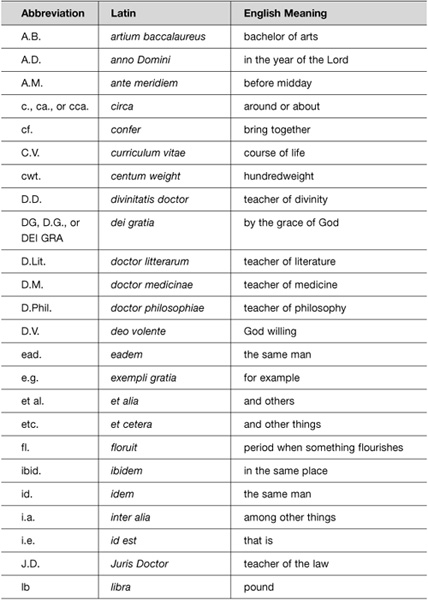
States and Territories
States and territories can be abbreviated in references and addresses, but do not abbreviate states and territories in normal writing. Abbreviations accepted by the U.S. Postal Service are listed on its Web site. Do not use periods with state abbreviations.
For addresses on envelopes, you do not need a comma to separate a city from a state abbreviation. If you spell out the state name, you do need a comma.
Example: Dallas TX or Dallas, Texas
For the District of Columbia, DC can be written with or without periods.
You can abbreviate Saint in place names.
Example: St. Louis
Things You Should Not Abbreviate
For formal business writing, do not abbreviate the following:
![]() Words like through (thru) or night (nite)
Words like through (thru) or night (nite)
![]() Days of the week
Days of the week
![]() Months
Months
![]() Words that begin a sentence
Words that begin a sentence
![]() People’s names, such as Charles (Chas.) or James (Jas.)
People’s names, such as Charles (Chas.) or James (Jas.)
![]() State names when not part of an address
State names when not part of an address
![]() Military titles
Military titles
Spacing and Periods for Abbreviations
Consider the following tips on the use of spacing and periods in abbreviations:
![]() Abbreviations of units of measure are written without periods.
Abbreviations of units of measure are written without periods.
Example: 30 ft, 20 lb
![]() When abbreviating inches, you need a period to avoid confusion with the word in.
When abbreviating inches, you need a period to avoid confusion with the word in.
![]() Use periods for lowercase abbreviations such as e.g. and i.e.
Use periods for lowercase abbreviations such as e.g. and i.e.
![]() Common long phrase abbreviations do not use periods, such as mph, mpg, or rpm.
Common long phrase abbreviations do not use periods, such as mph, mpg, or rpm.
![]() When an abbreviation with periods ends a sentence, the period for the abbreviation is used as the sentence period.
When an abbreviation with periods ends a sentence, the period for the abbreviation is used as the sentence period.
![]() Academic degrees can be written with or without periods.
Academic degrees can be written with or without periods.
Example: MBA or M.B.A, BS or B.S.
![]() People’s initials should include a period and space.
People’s initials should include a period and space.
Example: T. R. Smith
![]() Don’t let line breaks come in the middle of someone’s initials.
Don’t let line breaks come in the middle of someone’s initials.
Guidelines for Using Abbreviations in Your Writing
When introducing an abbreviation into your writing, spell out the term the first time it is used followed by the abbreviation in parentheses.
Example: cash on delivery (COD)
Use the abbreviation alone after the initial definition. Do not follow an abbreviation with a word that is included in the abbreviation.
Incorrect: ATM machine
Correct: ATM
To form the plural of an abbreviation or acronym, add a lower case s. Do not add an apostrophe. Do not make up abbreviations to save space in your business documents.
Abbreviations for Measurements
You can use abbreviations for common measurements when space is limited or when the measurements appear in a table. Table 2.2 lists the common abbreviations for measurements.
Table 2.2 Common Abbreviations for Measurements
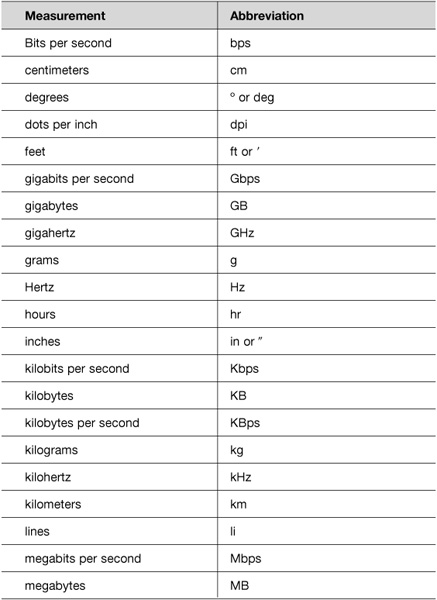
Abbreviations for Numbers
The abbreviation for number (no.) or the number sign (#) is normally not used.
Incorrect: Building No. 48
Correct: Building 48
Incorrect: Invoice #3219
Correct: Invoice 3219
Incorrect: Page no. 102
Correct: Page 102
In some situations, you may add the word number and not use the abbreviation.
Example: When we reviewed the list of charges against him, number five was discussed the most by the jury.
ABOVE, BELOW
Do not use above or below to reference tables, visuals, or forms on the current page or on a previous or next page. When the page is laid out, these terms may cause confusion. Repeat the name when referencing a table, visual, or form.
Example: You will see a list in Table 3. Keyboard Shortcuts …
ABSOLUTE FORM OF AN ADJECTIVE
An absolute adjective is an adjective that functions as a noun.
Example: the poor
ABSOLUTE PHRASE
An absolute phrase is a group of words consisting of a noun or pronoun, a participle, and modifiers.
Example: President of the workers’ union three out of four years [absolute phrase], his leadership experience really stood out.
Absolute phrases do not connect to or modify any other word in a sentence; instead, they modify the entire sentence. Absolute phrases are often treated as parenthetical elements set off from the rest of the sentence with a comma or a pair of commas.
ABSOLUTELY
The term absolutely should not be used in formal writing.
Incorrect: I am absolutely sure we’ll win the contract.
Correct: I am very sure we’ll win the contract.
ABSTRACT NOUNS
Abstract nouns describe qualities, feelings, states, concepts, and events that have no physical existence. Abstract nouns are used to describe things that cannot be detected by the five senses but that exist as ideas or feelings.
Example: hope, freedom, happiness, idea
Abstract nouns can be countable or uncountable. Abstract nouns that refer to events are usually countable.
Example: a concept
ACCENT MARKS
Foreign language words adopted into the English language sometimes use the accent marks from their source language. Most word processing software automatically adds accent marks to the words that require them.
Example: fiancé, protégé, cliché
French and Italian source words often contain grave (left-leaning) accent marks (e.g., è). A diaeresis (¨) over a letter signals the speaker that the letter begins a new syllable.
Example: noël and naïve
An umlaut (e.g., ü) looks similar to a diaeresis, but it modifies the sound of the vowel.
Some Spanish words use a tilde (ñ), which tells you that the n is pronounced like a y.
Example: piñata, niño
ACCEPT, EXCEPT
Accept is a verb that means to agree to take something from someone.
Example: I always accept criticism from my mentor because I greatly respect her opinion.
Except is a preposition or conjunction that means not including.
Example: I work every day except Saturday.
ACCESS, EXCESS
Think of access as part of the word accessible when determining its usage. Access means the ability to approach or enter, a way of approach, or the trait of being approachable.
Access can be a noun or verb.
![]() Noun: The only access to the storage area is through the break room.
Noun: The only access to the storage area is through the break room.
![]() Verb: I can access my stock portfolio online.
Verb: I can access my stock portfolio online.
Think of excess as part of the word excessive when determining usage. Excess means overabundance or overindulgence.
Excess can be a noun or an adjective.
![]() Noun: He was happy to have an excess of red pens.
Noun: He was happy to have an excess of red pens.
![]() Adjective: We were charged an excess baggage fee of $25.
Adjective: We were charged an excess baggage fee of $25.
ACRONYMS
An acronym is a type of abbreviation that is formed by taking letters from a long phrase.
Example: radar, radio detection and ranging
Acronyms save time in speaking and writing, but they can be unclear and come across as jargon if used too much in business writing.
An initialism is an acronym whose letters do not make a word; the letters are pronounced individually.
Example: CBS, CIA, NFL
ACTION VERBS
Action verbs express achievement or something that a person, place, or thing does.
Example: eat, smile, think, run, jump, leap, cry
Action verbs are concise, persuasive, and easy for readers to understand. Use action verbs when writing résumés, cover letters, and sales copy.
Table 2.3 provides sample action verbs for use in your writing.
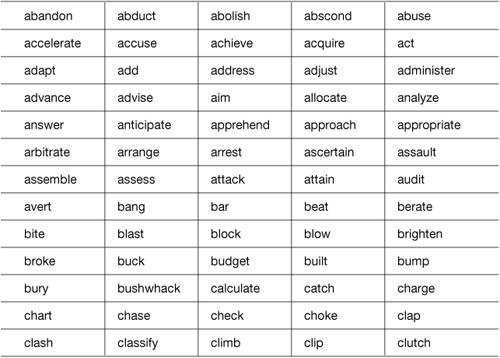
Active Voice
In sentences with an action verb (see Action Verbs), the subject performs the verb’s action.
Example: John mailed the letter.
Because the subject (John) does the action (mails the letter), the sentence is said to be in the active voice.
When the subject is acted on by the verb, the sentence is said to be in the passive voice.
Example: The letter was mailed by John.
For your business writing, you should emphasize the who or what that performs the action; that is, you should write using the active voice. The active voice is concise, easy to read, and clear. Always use the active voice for policies, procedures, and instructions.
Example: You should review your emails before sending them.
Name the performer of the action to make it easier to identify the subject and avoid the passive voice.
Weak: It was discovered by the students that their new teacher had been in the Marines.
Better: The students discovered their teacher had been in the Marines.
A.D.
A.D. comes from the Latin phrase anno Domini, which means “in the year of the Lord.” A.D. should be written in all caps with periods.
Adjectival Noun
An adjectival noun is an adjective that functions as a noun. Adjectival nouns are used to describe groups of people or things that share a common attribute.
Example: the poor, the rich, the young
Adjectival Opposites
Whenever you need to describe the opposite of an adjective, you can use an antonym. These opposite pairs of adjectives are called adjectival opposites. A thesaurus can help you find an appropriate antonym.
Example: The opposite of cold is hot.
Another way to form a negative adjective is with a prefix. Consider the following pairs:
![]() Fortunate, unfortunate
Fortunate, unfortunate
![]() Prudent, imprudent
Prudent, imprudent
![]() Considerate, inconsiderate
Considerate, inconsiderate
![]() Honorable, dishonorable
Honorable, dishonorable
![]() Alcoholic, nonalcoholic
Alcoholic, nonalcoholic
![]() Filed, misfiled
Filed, misfiled
A third way to form an adjectival opposite is to combine the adjective with less or least.
Example: That is the least expensive building on the block.
Adjective Phrase
An adjective phrase is a group of words used as an adjective in a sentence.
Example: The CEO is fond of classic rock [adjective phrase].
An adjective phrase can often include an adverb such as very or extremely.
Example: The status report is very late.
Example: My little brother is extremely afraid of the dark.
See Adjectives.
Adjectives
Adjectives are words that describe or modify a person, place, or thing.
Example: tall, solid, cold, green
Articles such as a, an, and the are adjectives.
A group of words containing a subject and verb may act as an adjective. Such a group is called an adjective clause.
Example: My best friend, who is much older than I am [adjective clause], is a doctor.
If the subject and verb are removed from an adjective clause, what’s left is an adjective phrase.
Example: He is the man who is keeping me employed [adjective phrase, once “who is” is removed].
Placement of Adjectives in a Sentence
Adjectives almost always appear immediately before the noun or noun phrase that they modify. Sometimes adjectives appear in a string; when they do, they must appear in a particular order according to category.
Adjectives appear in the following order:
1. Determiners—articles and other limiters
Example: a, an, five, her, our, those, that, several, some
2. Observation—postdeterminers and limiter adjectives and adjectives subject to subjective measure
Example: beautiful, expensive, gorgeous, dilapidated, delicious
3. Size and shape—adjectives subject to objective measure
Example: big, little, enormous, long, short, square
4. Age—adjectives describing age
Example: old, antique, new, young
5. Color—adjectives denoting color
Example: red, white, black
6. Origin—adjectives denoting the source of the noun
Example: American, French, Canadian
7. Material—adjectives describing what something is made of
Example: silk, wooden, silver, metallic
8. Qualifier—final limiter that is often part of the noun
Example: rocking chair, hunting cabin, passenger car, book cover
Example: an expensive, square, antique, black, French, wooden chinaware closet
When indefinite pronouns—such as something, someone, and anybody—are modified by an adjective, the adjective comes after the pronoun.
Example: That is something useful to know.
Use of Multiple Adjectives
Multiple adjectives of the same class are called coordinated adjectives and require a comma between them in a sentence. Consider whether you could have inserted and or but between the adjectives. If so, then use a comma between them.
Example: inexpensive but comfortable car. [If the but were not in the sentence, you would punctuate it as “inexpensive, comfortable car.”]
Degrees of Adjectives
Adjectives can express degrees of modification: positive, comparative, and superlative. Use the positive form when no comparisons are being made.
Positive form example: rich, lovely, beautiful
Use the comparative for comparing two things. Sometimes the word thanaccompanies the comparable adjective.
Comparable form example: richer, lovelier than, more beautiful
Use the superlative for comparing three or more things. Sometimes the word the precedes the superlative adjective.
Superlative form example: richest, the loveliest
The inflected suffixes -er and -est are used to form most comparative and superlative adjectives. Sometimes the suffixes -ier and -iest are added when a two-syllable adjective ends in y.
Example: friendlier, laziest
Be careful not to use the word more along with a comparative adjective formed with the -er suffix, or the word most along with a superlative adjective formed with the -est suffix.
Incorrect: more larger, most largest
Correct: larger, largest
Be careful not to form comparative or superlative adjectives that already describe a unique condition or extreme of comparison. Perfect and pregnant are good examples.
Incorrect: most perfect, more unique
Correct: perfect, unique
Irregular Form Adjectives
Some adjectives have irregular forms in the comparative and superlative degree, as seen in Table 2.4.
Table 2.4 Irregular Comparative and Superlative Degree Forms
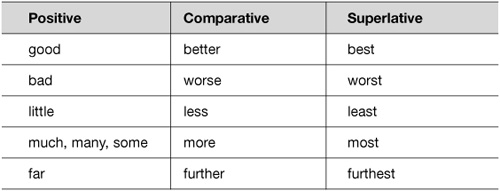
A-Adjectives
The so-called a-adjectives all begin with the letter a.
Example: ablaze, afloat, afraid, aghast, alert, alike, alive, alone, aloof, ashamed, asleep, averse, awake, aware
These adjectives are used after a linking verb.
Example: The man was ashamed.
Sometimes you can use an a-adjective before the word it modifies.
Example: the alert driver
A-adjectives are sometimes modified with very much.
Example: The man was very much ashamed.
ADJUNCTS, DISJUNCTS, AND CONJUNCTS
When adverbs are integrated into the flow of a sentence, the adverb is an adjunct.
Example: Rebeccca, I don’t really [adjunct adverb] care.
When an adverb does not fit into the sentence flow, it is said to be disjunctive.
Disjunctive adverbs are usually set off by a comma or a series of commas. A disjunctive adverb acts as if it is evaluating the rest of the sentence.
Example: Honestly [disjunctive or conjunctive adverb], Rebecca, I don’t really care.
Conjunctive adverbs serve as a connector within the flow of the text, signaling a transition.
Example: If they start talking sports, then [conjunctive adverb] I’m leaving.
Adverbial conjunctions are words like however and nevertheless.
Example: I love this town; however, I don’t think I can afford to live here.
ADVERBIAL CLAUSE
A group of words containing a subject and a verb act as an adverb (modifying another verb in the sentence); this is called an adverbial clause.
Example: When this conference is over [adverbial clause], we’re going home for dinner.
ADVERBIAL PHRASE
An adverbial phrase is a group of words that act as an adverb in a sentence.
Example: Our departmental budgets were due in October last year [adverbial phrase].
ADVERBS
Adverbs modify verbs, adjectives, or another adverb. Adverbs often describe when, where, why, or under what circumstances something happened.
There are five main types of adverbs:
![]() Adverbs of manner
Adverbs of manner
Example: She spoke slowly and walked quietly [two adverbs of manner].
![]() Adverbs of place
Adverbs of place
Example: She lives there [place] now.
![]() Adverbs of frequency
Adverbs of frequency
Example: She drives to work daily [frequency].
Example: She slept late [time].
![]() Adverbs of purpose
Adverbs of purpose
Example: She broke the window intentionally [purpose].
Adverbs usually end in -ly; however, many words not ending in -ly can serve as adverbs.
Example: She drove fast. … He bowled the worst of us.
Some words that end in -ly are not adverbs.
Example: Lovely, lonely, early, motherly, and friendly are adjectives.
A small group of adverbs have two forms: those that end in -ly and those that don’t. In some cases, the two forms have different meanings.
Example: They departed late.
Example: Lately, they can’t seem to arrive on time.
In most cases, the form without the -ly should be reserved for casual conversation and not business writing.
Casual example: He did her wrong.
Business writing example: He treated her poorly.
Adverbs can modify adjectives, although adjectives can’t modify adverbs.
Example: The executive showed a wonderfully casual attitude.
Adverbs can have comparative and superlative forms.
Comparative example: You should walk faster if you want to get some exercise.
Superlative example: The candidate who types fastest gets the job.
Sometimes words like more and most, less and least are used to indicate the comparative or superlative forms.
Example: The house was the most beautifully decorated home on the tour.
Example: Her soup was less tastily seasoned than the others.
Another construction used to create adverbs is the use of as-as.
Example: He can’t read as fast as his cubical mate.
Adverbs are often used as intensifiers to convey a greater or lesser meaning. Intensifiers have three functions:
![]() Emphasize
Emphasize
Example: I really [intensifier] don’t like him. He simply ignores me.
![]() Amplify
Amplify
Example: He completely wrecked his new car. … I absolutely love fresh fruit.
![]() Tone down
Tone down
Example: I kind of like this restaurant’s food. … She mildly disapproved of his smoking.
Prepositional Phrases Acting as Adverbs
Prepositional phrases frequently function as an adverb.
Example: She works on weekends [prepositional phrase].
Infinitive Phrases Acting as Adverbs
An infinitive phrase can act as an adverb.
Example: The assistant ran to catch the bus [infinitive phrase].
Adverbs in a Numbered List
When you create a numbered list, do not use adverbs with an -ly ending (secondly, thirdly, etc.). Instead, use first, second, third, and so on.
Adverbs to Avoid
Adverbs like very, extremely, and really don’t intensify anything. They are often too imprecise for business writing.
Positioning Adverbs in a Sentence
Adverbs have the unique ability to be placed in different places within a sentence. Adverbs of manner are unusually flexible about where they are located:
Example: Solemnly [adverb] the president returned the salute.
Example: The president solemnly returned the salute.
Example: The president returned the salute solemnly.
Adverbs of frequency should appear at specific points in a sentence:
![]() Before the main verb
Before the main verb
Example: He never gets up before noon.
![]() Between the auxiliary verb and the main verb
Between the auxiliary verb and the main verb
Example: I have rarely called my sister without a good reason.
![]() Before the verb used to
Before the verb used to
Example: I always used to talk to him on the phone.
Indefinite adverbs of time can appear either before the verb or between the auxiliary and the main verb:
Example: He finally showed up for the meeting.
Example: He has recently traveled to India.
The adverb too usually comes before adjectives and other adverbs.
Example: He ate too fast. … He eats too quickly.
When too appears in a sentence after an adverb, it is a disjunct and is set apart with a comma.
Example: Linda works hard. She works quickly, too.
The adverb too and another adverb are sometimes followed by an infinitive verb.
Example: He talks too slowly to keep my attention.
The adverb too can also be followed by the prepositional phrase for plus the objective of the preposition plus an infinitive.
Example: This food is too spicy for Martha to eat.
Order of Adverbs
When a sentence contains more than one adverb, the adverbs should appear in a certain order. Shorter adverbial phrases should precede longer ones. The more specific phrase should go first.
Table 2.5 shows the correct order for adverbs.
Table 2.5 Correct Order of Adverbs

Inappropriate Adverb Order
Modifiers can sometimes attach themselves to the wrong word.
Example: They reported that M. B. Wilwau had won the lottery on the evening news [misplaced adverbial phrase].
Move the modifier immediately after the verb it is modifying (reported) or to the beginning of the sentence.
Example: They reported on the evening news that M. B. Wilwau had won the lottery.
Alternative example: On the evening news, they reported that M. B. Wilwau had won the lottery.
The adverbs only and barely are often misplaced modifiers.
Unclear: He only grew to be five feet tall.
Clearer: He grew to be only five feet tall.
Viewpoint Adverbs
A viewpoint adverb usually comes after a noun and is related to an adjective that precedes the noun.
Example: Investing all our money in technology stocks was probably not a good idea financially.
Focus Adverbs
A focus adverb is used to limit a specific aspect of the sentence.
Example: He got a promotion just for being there.
Negative Adverbs
Negative adverbs can create a negative meaning in a sentence without the use of words like no, not, neither, nor, or never.
Example: He seldom smiles.
Example: He hardly eats anything since he got sick.
ADVICE, ADVISE
Advice is a noun that means an opinion offered by someone suggesting how you should act or respond.
Example: I always talked to my uncle, whenever I wanted advice about business.
Advise is a verb that means to provide information or guidance.
Example: I advise my students to keep a dictionary handy whenever they are writing.
AFFECT, EFFECT
Affect is commonly used as a verb, meaning to influence. Affect can be used as a noun only as a psychological term, meaning feeling or emotion.
Effect is a verb meaning to bring about. It is also used as a noun, meaning a result or consequence, or a mental impression.
Incorrect: The light effects my vision.
Correct: The light affects my vision.
Incorrect: Can you affect a change in the operation?
Correct: Can you effect a change in the operation?
AFFIXES
An affix consists of one or more letters added to a word to change its meaning. There are two types of affixes:
![]() Prefix—added to the beginning of a word
Prefix—added to the beginning of a word
Example: im + possible = impossible
![]() Suffix—added to the end of the word
Suffix—added to the end of the word
![]() Adding -ly to the end of some adjectives creates an adverb.
Adding -ly to the end of some adjectives creates an adverb.
Example: wonderful + -ly = wonderfully
AFRICAN-AMERICAN
African-American is a term used to describe Americans of African descent. It is traditional to hyphenate African-American, but the hyphen is optional. Always use a hyphen if the term is being used as an adjective.
Example: He was an African American who idolized African-American business leaders.
AGE
When giving the age of a person or a period of time, write out up to and including one hundred; use figures over one hundred:
Example: She is twelve years old.
Example: He has held the same position for twenty-six years.
Example: She is now 105 years of age.
Example: The company has been in this city for 102 years.
For compound adjectives denoting age, the words designating time may be used before old, but in that event the words year and day must appear in the singular:
Example: twelve-day-old baby elephant
Example: six-month-old pony
Example: 200-year-old building
Example: three-day-old kitten
AGENTS
The person or thing that performs the action described by a verb is called an agent. Agents are often used when writing in the passive voice along with the word by.
Example: The doctor’s career was ruined by the lawsuit. [In this example, the lawsuit is the agent because it performed the act that ruined the doctor’s career.]
AGREEMENT
When the elements of a sentence have a grammatical relationship that affects the form of one or more of the words, agreement occurs.
Example: four boys [The word four requires the form of the word boy to become the plural boys.]
Agreement is also known as concord.
AID, AIDE
Both aid and aide mean helper or assistant. Aide comes from aide-de-camp, a military title. Use this form to describe people who serve as assistants.
Example: a congressional aide
Aid is often used for helpful objects.
Example: job aid, hearing aid, visual aid
ALIKE
A LITTLE
ALLEGORIES
An allegory is a narrative that symbolically suggests something else. An allegory is an extended metaphor with two meanings. The underlying meaning of an allegory usually has moral or social significance.
![]() Aesop’s Fables
Aesop’s Fables
![]() The Republic by Plato
The Republic by Plato
![]() The Book of Revelation from the Bible
The Book of Revelation from the Bible
![]() The Masque of the Red Death by Edgar Allan Poe
The Masque of the Red Death by Edgar Allan Poe
![]() The Lord of the Flies by William Golding
The Lord of the Flies by William Golding
![]() The Chronicles of Narnia by C. S. Lewis
The Chronicles of Narnia by C. S. Lewis
ALLITERATION
Alliteration is a narrative technique that uses words beginning with the same letter to sound poetic.
Example: “The moan of doves in immemorial elms, and the murmuring of innumerable bees.”—Tennyson
ALL RIGHT, ALRIGHT
All right means okay, acceptable, or unhurt. Always spell all right as two words, never one. Alright is an informal way to spell all right and should not be used in formal business writing.
Incorrect: It will be alright if you wish to go.
Correct: It will be all right if you wish to go.
ALLUSION, ILLUSION
An allusion is a reference to something. The words allude or alluded are more commonly used in writing. Allusions are often literary in nature.
Example: His allusion to water in his writing foreshadowed the great flood that would appear at the end of the book.
An illusion is a mirage, hallucination, or magic trick.
Example: The performance involved the illusion of sawing a woman in half.
ALONE, LONELY
Alone can function as an adjective or adverb. Alone means to be without other people or to be on your own.
Example: Roger likes living alone.
Example: The child was left alone in the house.
Lonely is an adjective that means being unhappy because you are alone. Just being alone does not make a person lonely.
Example: Marcia felt lonely after her husband passed away.
A LOT, ALOT, ALLOT
A lot, meaning a large amount or number, may be used to modify a noun. Using the word many or numerous instead of a lot is better form.
Example: We’ll need a lot of hands to finish clearing the land.
Better: We’ll need many hands to finish clearing the land.
A lot can also be used as an adverb to mean very much or very often.
Example: She looks a lot like her mother.
Alot is not a word.
Allot is a verb that means to give or share for a particular purpose.
Example: We were allotted one pillow and blanket per person.
ALREADY, ALL READY
Already denotes time and means before the present time or earlier than expected. All ready denotes preparation and means completely ready.
Example: She had already arrived.
Example: We are all ready to leave.
ALTOGETHER, ALL TOGETHER
Altogether is an adverb that means completely, in total, quite, or in all. All together is an adverb that means in one place or together as one group.
Example: She is altogether pleasant.
Example: His bills came to fifty-seven dollars altogether.
Example: The books were all together on one shelf.
AMBITRANSITIVE VERBS
An ambitransitive verb can be both transitive and intransitive without changing the verb form.
Example: I read the book. [Read is transitive and the book is the direct object.]
Example: I always read in the den. (Read is intransitive and there is no direct object after the verb.)
Other ambitransitive verbs are:
![]() Broke
Broke
Example: I broke the mirror. [transitive]
Example: The mirror broke. [intransitive]
![]() Change
Change
Example: I changed my pants. [transitive]
Example: The pants were changed. [intransitive]
![]() Sunk
Sunk
Example: I sunk the sailboat. [transitive]
Example: The sailboat sunk. [intransitive]
AMERICAN ENGLISH, BRITISH ENGLISH
Certain words are spelled differently in American English than in British English. Table 2.6 is a list of words that have this peculiar treatment.
Table 2.6 Differences Between American and British Spellings

AMONG, BETWEEN
AMPERSAND
The ampersand (&) means “and.” Do not use the ampersand in text, titles, or headings.
A.M., P.M.
A.M. means ante meridiem, which is Latin for “before midday.” It stands for the time after midnight and before noon. P.M. means post meridiem, which is Latin for “after midday.” It stands for the time after noon and before midnight.
When using A.M. or P.M.:
![]() Don’t write “12 A.M.” or “12 P.M.”; these forms cause confusion. Instead, write “12 noon” or “12 midnight.”
Don’t write “12 A.M.” or “12 P.M.”; these forms cause confusion. Instead, write “12 noon” or “12 midnight.”
![]() You can use upper or lower case and periods: A.M. and P.M, or a.m. and p.m.
You can use upper or lower case and periods: A.M. and P.M, or a.m. and p.m.
![]() Do not add the word o’clock when writing times and including A.M. or P.M.
Do not add the word o’clock when writing times and including A.M. or P.M.
AN
ANADIPLOSIS
Anadiplosis is a narrative and speechwriting technique where a word or phrase at the end of a sentence or phrase is repeated at the beginning of the next sentence or phrase.
Example: Here, we expect commitment. Commitment is the key to being successful in this business.
ANAPHORA
Anaphora refers to the use of words or phrases such as pronouns that point backward to something earlier in a sentence.
Example: He wanted the newspaper and asked me to finish reading it [anaphoric, refers to the noun “newspaper”].
AND ALSO
And also is a redundant phrase. Use either word separately, but not the two together.
AND/0R
And/or is a legal term that means you can choose between two alternatives or choose both. Use and/or sparingly in your business writing because it is often seen as jargon. Check to make sure a simple or would do in your sentence. If choosing one of the alternatives eliminates the other, then it isn’t an and/or situation.
ANGRY, MAD
ANIMATE NOUNS
Animate nouns refer to people, animals, and living things. Inanimate nouns refer to nonliving things.
ANTAGONYMS
Antagonyms are words that can mean the opposite of themselves. Antagonyms are also known as contranyms or autoantonyms. The following are some examples of antagonyms:
![]() Clip
Clip
Example: Clip [attach] the receipts to your expense report.
Example: Clip [cut from] the hedges.
![]() Left
Left
Example: How much time is left [remaining]?
Example: They have already left [have gone].
![]() Bound
Bound
Example: I’m bound [moving toward] for Los Angeles.
Example: The criminal was bound [unable to move] with handcuffs.
![]() Buckle
Buckle
Example: You had better buckle [hold together] your seatbelt.
Example: Her knees buckled [collapsed] under the weight.
![]() Cut
Cut
Example: Those kids cut [got into] in line.
Example: Those kids cut [got out of] class.
![]() Dust
Dust
Example: The maid is going to dust [remove dust] the living room.
Example: The police are going to dust [apply dust] for fingerprints.
![]() Citation
Citation
Example: The city council gave me a citation [an award] for my volunteer efforts in the community.
Example: The police gave me a citation [a penalty] for speeding.
ANTECEDENT
An antecedent is a word, phrase, or clause referred to by a pronoun. In a series of sentences, the antecedent is understood after being referenced once in a sentence or previous sentence, and therefore a pronoun is used to avoid repetition.
In the following example, the antecedent and pronoun are underlined.
Example: The Titanic was lost on its maiden voyage. It was said to be unsinkable.
Third-person pronouns (he, she, it, they) need an antecedent to be clear. First-person pronouns like I and you do not.
A pronoun must agree with its antecedent in three ways:
![]() Person—It must specify a particular person.
Person—It must specify a particular person.
![]() Number—It must distinguish between singular and plural.
Number—It must distinguish between singular and plural.
![]() Gender—It must distinguish between masculine and feminine.
Gender—It must distinguish between masculine and feminine.
ANTI-
The prefix anti- comes from Greek and means against. Anti- is often added to words to create new words that mean the opposite of the original word.
Example: anticrime, antisocial, antiglare
ANTIMETABOLE
Antimetabole is a technique where a word or phrase in one clause or phrase is repeated in the opposite order in the next clause or phrase.
Example: “Ask not what your country can do for you; ask what you can do for your country.”—John F. Kennedy
Example: “The Sabbath was made for man, and not man for the Sabbath.”—Jesus (Mark 2:27)
Example: “Now this is not the end. It is not even the beginning of the end, but it is, perhaps, the end of the beginning.” —Winston Churchill
ANTONYMS
A word that means the opposite of another word is an antonym.
Example: Hot is the antonym of cold.
Antonyms can be made by adding the prefix un-.
Example: able, unable; happy, unhappy; suitable, unsuitable; likely, unlikely
Antonyms can be made by adding the prefix non-.
Example: sense, nonsense; conformist, nonconformist
Antonyms can be made by adding the prefix in-.
Example: sensitive, insensitive; discreet, indiscreet
ANY, EITHER
Any refers to one of several. Either refers to one of two.
Correct: You may have any of the six books.
Correct: Either of those two cars will be acceptable.
ANY, SOME
Any and some are used to talk about indefinite quantities. Use some for positive statements and any for negative statements and questions.
Example: I asked the waiter to get me some water.
Example: Do you have any water?
Example: They don’t have any.
APART, A PART
Apart is an adverb that means separated by distance or time.
Example: I feel sad when we’re apart.
A part is a noun that means a piece of something.
Example: I’d like to be a part of your team.
APODOSIS
The main clause in a condition sentence is called an apodosis.
Example: If you ate there, you’d know what I mean. [The apodosis is “you’d know what I mean,” and “if you ate there” is the if clause.]
APOSTROPHE
An apostrophe (’) may denote that a word has been contracted intentionally.
Example: It’s time to go.
Example: Haven’t you finished the task?
An apostrophe can be used to show possession.
![]() To show possession for a singular noun, add ’s.
To show possession for a singular noun, add ’s.
Example: the office’s conference room
![]() To show possession for a plural noun ending in s, add the apostrophe after the s.
To show possession for a plural noun ending in s, add the apostrophe after the s.
Example: the employees’ parking lot
![]() To show possession for plural nouns not ending in s, add ’s.
To show possession for plural nouns not ending in s, add ’s.
Example: men’s room
The plural of compound nouns and joint possessive nouns is formed by adding ’s to the second word only.
Example: Hitesh and Kalpana’s house
If the items are separately owned, add ’s to each of the compound nouns.
Example: Mary’s and John’s coats
For a proper name ending in s, use ’s.
Example: Lewis’s hat
Example: Miss Bliss’s book
Note: Two proper names are traditionally observed as exceptions:
![]() Moses’ robe
Moses’ robe
![]() Jesus’ parable
Jesus’ parable
For plural proper names ending in s, use only an apostrophe.
Example: The Joneses’ boots were left in the hall.
No apostrophe is used with possessive pronouns.
Example: his, hers, its, yours, ours, theirs
The apostrophe is also used to express duration of time.
Example: a day’s drive
Example: a year’s worth of happiness
APPEARS, DISPLAYS
When writing about computer software, keep in mind that the word displays requires a direct object, while appears does not require a direct object.
Incorrect: The log-on screen displays.
Correct: The log-on screen appears.
Correct: The screen displays a warning message if you enter an incorrect password.
APPENDIX
An appendix is a separate section at the end of a document that provides supplementary information. An appendix provides additional reference material and details that were not necessary for all readers of the main document.
Example: statistics, detailed procedures, maps, diagrams
Documents can have more than one appendix, each containing a different type of information. Each appendix is labeled Appendix A, Appendix B, Appendix C, and so forth. When there is just one appendix in a document, title it Appendix.
If appendix items are referred to in the main document, arrange them in the same order as they are mentioned in the text.
Appendices should appear in the document’s table of contents.
APPOSITION
An apposition is a writing technique that involves placing a noun or noun phrase next to another that explains it.
Example: John Sullivan, the mayor [in apposition, explaining who John Sullivan is], will be visiting the high school on Wednesday.
APPOSITIVES
An appositive is a noun or phrase that renames or amplifies a word that immediately precedes it.
Example: Gary, my brother [appositive], is a psychologist.
An appositive phrase renames or amplifies a word that immediately precedes it. Use commas to separate the nonessential appositive from the rest of the sentence.
Example: My favorite professor, a world famous author [nonessential appositive], just won a prestigious literary award.
Be careful about the case of an appositive. Check the case by substituting the noun that the appositive modifies.
Incorrect: My manager gave two of us, Ted and I, a bonus for our participation in the diversity task force.
Check: My manager gave I a bonus.
Correct: My manager gave two of us, Ted and me, a bonus for our participation in the diversity task force.
Check: My manager gave me a bonus.
ARTICLES
Articles, determiners, and quantifiers are little words that precede and modify nouns.
Example: the dog, a cat, those people, whatever purpose, either way, your choice
Sometimes these words tell you whether the subject is something specific or more general. Sometimes they tell you how much or how many.
The following is a list of determiner categories:
![]() Articles—an, a, the
Articles—an, a, the
![]() Determiners—articles and other limiters such as a, an, five, her, our, those, that, several, some
Determiners—articles and other limiters such as a, an, five, her, our, those, that, several, some
![]() Possessive nouns—Kevin’s, the worker’s, my mother’s
Possessive nouns—Kevin’s, the worker’s, my mother’s
![]() Possessive pronouns—his, your, their, whose
Possessive pronouns—his, your, their, whose
![]() Numbers—one, two, three, etc.
Numbers—one, two, three, etc.
![]() Demonstrative pronouns—this, that, these, those, such
Demonstrative pronouns—this, that, these, those, such
The three articles a, an, and the are a type of adjective. The is called the definite article because it tends to name something specific. A and an are called indefinite articles, because they refer to things in a less specific way. The is used with specific nouns and is required when the noun refers to something unique.
Example: The earth orbits the sun.
The is also used for abstract nouns.
Example: The City of Atlanta has encouraged the use of mass transit.
A is used before singular nouns that begin with consonants.
Example: a dog, a cat, a mountain
An is used before singular nouns that begin with vowels or vowel-like sounds.
Example: an apple, an eagle, an invitation.
AS, LIKE
ASSURE, INSURE, ENSURE
ASTERISKS
Asterisks are used to call out a footnote on a page. The following are some uses for asterisks in your writing:
![]() Three spaced asterisks centered on a page may be used to signal a change in thought.
Three spaced asterisks centered on a page may be used to signal a change in thought.
![]() One or more asterisks are sometimes used to strike out letters when writing profanity.
One or more asterisks are sometimes used to strike out letters when writing profanity.
![]() Asterisks are sometimes used as bullets when creating a list.
Asterisks are sometimes used as bullets when creating a list.
![]() In computer science, an asterisk is used to represent a wildcard character.
In computer science, an asterisk is used to represent a wildcard character.
![]() In telephony, an asterisk is included on the telephone keypad and is referred to as “star.”
In telephony, an asterisk is included on the telephone keypad and is referred to as “star.”
AS TO WHETHER
Avoid using the phrase as to whether. The word whether usually suffices.
AS WELL AS
As well as is a synonym for in addition to and for the word and. Avoid using as well as in business documents. Instead use in addition to or and.
Correct: With the new printer, you can print beautiful color photographs in addition to normal black-and-white text documents.
Avoid: With the new printer, you can print beautiful color photographs as well as normal black-and-white text documents.
AUTOANTONYMS
AUXILIARY VERBS
Auxiliary verbs are used to form verb phrases. There are four auxiliary verb groups:
![]() To be
To be
![]() To have
To have
![]() Model auxiliaries
Model auxiliaries
![]() To do
To do
The auxiliary verb to be is used in both the progressive tense and the passive voice.
Example of progressive tense: You are hitting.
Example of passive voice: You are hit.
The auxiliary verb to have is used in the perfect tense.
Example: I have finished my dinner.
Example: I had finished my dinner.
Example: I have been finished with my dinner.
Model auxiliaries determine whether a verb is a fact, desire, possibility, or command.
Example of fact: I can walk.
Example of command: I must walk.
Example of desire: I should walk.
Example of possibility: I may walk.
The auxiliary verb to do is used in questions, negatives, or emphatic statements.
Example of question: Does he smoke?
Example of negative: He smokes, doesn’t he?
Example of emphasis: Despite the fact he’s coughing, he does smoke.
AVERAGE, MEAN, MEDIAN
Average is a mathematical term that is determined by adding two or more numbers together and dividing the sum by the number of items.
Example: The average of 2, 4, 6, 8, 10 is 6. [2 + 4 + 6 + 8 + 10 = 30, 30 ÷ 5 = 6]
Average is also known mathematically as the arithmetic mean. The middle number in a series of numbers is the median.
Example: The median of 2, 4, 6, 8, 10 is 6.
A WHILE, AWHILE
A while is a period of time. Awhile is an adverb that means for a time and should never be used as the object of a preposition (which can only be a noun or pronoun).
Incorrect: Please come to my home for awhile before you start your journey.
Correct: Please come to my home for a while before you start your journey.
Correct: Relax awhile before you begin the task.
AWFUL, AWFULLY
Awful can mean extremely disagreeable or exceedingly great.
Example: It was an awful experience. It was an awful lot of money.
Never use awful or awfully as a synonym for very.
Incorrect: She performed an awfully difficult task.
Correct: She performed a very difficult task.
Incorrect: Bill is awfully smart.
Correct: Bill is very smart.

